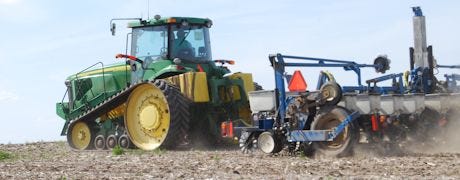March 25, 2013

How deep should you plant corn? Several factors affect the choice of corn seeding depth. Although many areas of Iowa and the Corn Belt have received late-winter precipitation, dry soil is still a concern in areas where tillage allows significant surface drying or where precipitation has not occurred. A recent ISU/ICM online newsletter article titled "Corn Seeding Depth: Back to the Basics", discusses how to select the appropriate seed depth. In the following article, Mark Hanna, Iowa State University Extension ag engineer, focuses on planter adjustment settings and considerations if seed is planted deeper than normal due to dry conditions in the upper 2 inches at the surface of the field.

PLANTING INTO DRY SOIL: When soil is dry and you're pulling into the field to plant corn, you need to think about planting depth and other factors to maximize moisture for rapid germination. Several factors affect your choice of corn seeding depth, says Mark Hanna, ISU Extension ag engineer. Although many areas of Iowa have received late winter precipitation this winter-spring, dry soil is still a concern in areas where tillage allows significant drying of the soil surface or where rain hasn't occurred.
Dry surface soil suggests you need to plant corn at deeper planting depths to obtain enough moisture for rapid germination. The seed depth adjustment on planters controls the distance between the bottom of the double-disc seed opener and bottom of depth-gauge wheels. Most planter row units have the ability to adjust this difference to at least 3 or 4 inches. Simply adjusting this depth difference between gauge wheels and seed opener, however, will not automatically mean seed is placed at the adjustment depth. A certain amount of weight or down-force is required to push the seed opener into the soil before the adjacent depth wheel comes into contact with the field surface. How much down-force is required, increases with increasing penetration depth. This is similar to the increased force that is required to drive a spade deeper into the soil.
Check to make sure depth-gauge wheels are in contact with the soil surface
It's always a good idea to make sure depth-gauge wheels are in contact with the soil surface. This check is particularly necessary when planting at deeper-than-normal depths or if dry soil increases penetration resistance encountered by the seed opener.
If gauge wheels are not on the soil surface, extra weight must be transferred to the row unit via the down-force system on the parallel links attaching the row unit to the planter frame. In some cases, extra weight may be required on the planter toolbar frame to allow penetration of the seed opener. This last issue is more commonly encountered when a large number of row units are used on a given planter toolbar (such as with a narrow-row or split-row planter) or when separate fertilizer injectors are used on the planter.~~~PAGE_BREAK_HERE~~~
Rather than relying strictly on depth adjustment between the bottom of the seed opener and bottom of depth-gauge wheels, an alternative approach to increasing the depth of planting the seed to a zone of adequate moisture is to create a furrow ahead of the planter by setting the row cleaner depth deeper than usual. This concept loosens soil for easier penetration of the seed opener. More aggressive or deeper depth settings may remove an inch or two of surface soil before insertion of the seed by the seed opener and depth-gauge wheels.
Creating a furrow with row cleaners may be simplest way to plant seed deeper
Creating a furrow with row cleaners may be the simplest method to insert seed deeper into the soil than is ordinarily capable with the planter's seed depth adjustment (typically 3 to 4 inches). This approach has worked well for some operators in previous planting situations with dry surface soil. As mentioned in the article above on corn seeding depth, this approach also carries potential risks if rains occur during early germination and growth. Rainfall can puddle and seal tilled soils affecting the ability of corn to emerge. Even if corn has emerged, excessive water runoff erodes soil and can wash seed and plants from furrows if rows are sloping.
Contrary to planting in moist or wet soil, increasing down pressure somewhat on closing wheels can help seed-to-soil contact. Some extra down pressure on depth-gauge wheels slightly increases seed depth and increases emergence rate, bringing additional moisture into the seed zone by increasing capillary action on the soil water.
Summing up: Many planters allow seed depth to be adjusted 3 to 4 inches. Actual depth should be checked, however, to ensure penetration of seed openers and accurate seed placement. Row cleaners may be used as an aid for deeper planting, but subsequent rainfall can create soil sealing or erosion. Greater down-pressure than normal may aid seed-to-soil contact.
You May Also Like




